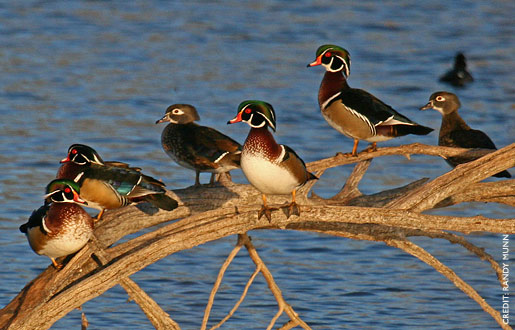The Wood Duck is one of the most colorful ducks out there and by far my favorite duck to watch and hunt. Fast agile flyers, bright colors and the unmistakable squealing sound are just a few characteristics that make them special to me. I remember one overcast and misty morning when my son and I were out bowhunting deer and walking down a old logging trail only to have a dozen plus Wood Ducks explode out of a tree above us. Since then both of us have been a fan of the Wood Duck.
With almost 50 inches of snow on the ground over the past few weeks and more on the way as well as unbearable single digit temps I need a indoor project so why not make some Wood Duck boxes. Because Wood Ducks are perching ducks and cavity nesters, this offers up unique opportunities to lend a helping hand to your local populations.
 |
| Courtesy of Ducks Unlimited - ducks.org |
Habitat loss has been and continues to be a leading contributor to waterfowl populations and the loss of bottomland hardwood forests was pushing the Wood Duck near extinction. Female Wood Ducks typically build their nests in tree cavities near
wetlands. They carefully inspect the site for a variety of
characteristics, including size, shape and security from predators and
the elements. In many areas, wood ducks have difficulty finding suitable
natural nesting sites. Wood duck boxes provide a man-made alternative,
where hens can nest in relative safety from predators. Creating a wood duck box and strategically placing it can draw birds
into an area and create a local population. Location and proper
maintenance are the keys to successfully assisting wood duck breeding
habits in your area.
Finding a suitable site to
place wood duck boxes can be challenging and you need to be aware of the following.
- Suitable brood habitat must be available close by in order for ducklings to survive once they
exit the box.
- Shallow, fertile wetlands with thick cover
and an abundance of invertebrates typically provide the best habitat for
broods.
- Wood Duck boxes should be erected on either wooden posts or
metal poles outfitted with predator guards.
You can download
wood duck box building instructions and learn much more about maintenance, placement, waterfowl ID, a ducks life cycle and other ways you can help conserve waterfowl and wetlands by visiting
Ducks Unlimited Waterfowl Biology Page.
You can also check into your local waterfowl organizations and chapters to see if they have a wood duck box building day like our
Connecticut Waterfowlers Association will on March 14th from 10:100 am until 3:00pm at Flaherty Field Trial Area in East Windsor. you can get more information here:
CWA Wood Duck Box building day.
If you are not a member of Ducks Unlimited and would like to learn how you can help DU with their wetland and waterfowl conservation mission please check out there website at:
www.ducks.org.
Now get your boxes built because I'm sure all this snow won't stick around forever and spring is just around the corner. Well I hope it is!





